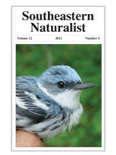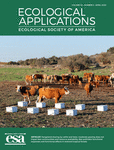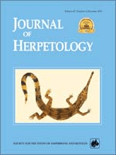
SOUTHEASTERN NATURALIST
Scope & Guideline
Bridging Local Insights with Global Perspectives
Introduction
Aims and Scopes
- Ecological Research:
The journal emphasizes empirical studies that explore the ecological dynamics of various species and their habitats, including research on aquatic and terrestrial ecosystems. - Conservation Biology:
A core area of focus is on conservation strategies and the management of threatened and endangered species, with a particular emphasis on species endemic to the southeastern United States. - Biodiversity Assessment:
The journal publishes studies that assess biodiversity, including new species descriptions and evaluations of population dynamics across different taxa. - Impact of Anthropogenic Factors:
Research examining the effects of human activities, such as urbanization, agriculture, and climate change, on wildlife and ecosystems is a recurring theme. - Innovative Methodologies:
The use of novel techniques, such as environmental DNA (eDNA) analysis and camera trapping, to study species distributions and behaviors is increasingly featured.
Trending and Emerging
- Climate Change Adaptation Studies:
Increasingly, the journal features research on how species and ecosystems are adapting to climate change, emphasizing the need for conservation strategies that incorporate resilience planning. - Use of Advanced Technology in Ecology:
There is a growing trend in the use of innovative technologies such as drones, remote sensing, and eDNA to enhance ecological research and monitoring, reflecting a broader shift towards data-driven conservation. - Community Ecology and Interactions:
Papers that explore species interactions within communities, including predator-prey dynamics and mutualistic relationships, are becoming more prevalent, highlighting the importance of ecological networks. - Human-Wildlife Interactions:
Research focusing on the impacts of human activities on wildlife behavior and ecology is gaining traction, addressing the need to understand and mitigate human-wildlife conflicts. - Restoration Ecology:
There is an emerging focus on restoration ecology, with studies aimed at rehabilitating degraded ecosystems and assessing the success of various restoration techniques.
Declining or Waning
- Invasive Species Studies:
While the journal previously published numerous papers on invasive species and their impacts, there has been a noticeable reduction in this focus, potentially indicating a shift towards more localized conservation efforts. - Traditional Taxonomic Studies:
There appears to be a decline in studies focused solely on taxonomic revisions or descriptions without ecological context, as the journal increasingly favors research that integrates taxonomy with ecological or conservation implications. - General Habitat Assessments:
Research that merely describes habitats without linking to specific ecological outcomes or conservation strategies has become less common, as the journal seeks to publish more impactful studies.
Similar Journals

SPIXIANA
Elevating Academic Discourse in Animal ScienceSPIXIANA is a distinguished journal dedicated to the fields of animal science and zoology, published by VERLAG DR FRIEDRICH PFEIL in Germany. With the ISSN 0341-8391, it has been contributing to the scientific community since its inception, with volumes converging from 2008 to 2024. Although currently listed in the Q4 quartile of the 2023 category rankings for Animal Science and Zoology, it provides a vital platform for researchers and professionals to disseminate significant findings in the field. Despite being unindexed in open access, SPIXIANA ensures that vital research reaches its audience, enhancing academic discourse and furthering our understanding of zoological sciences. Its commitment to sharing rigorous scientific research make it an important resource for anyone passionate about animal biology and conservation.

Insect Conservation and Diversity
Fostering Collaboration for a Sustainable FutureInsect Conservation and Diversity is an esteemed academic journal dedicated to the field of insect science, published by WILEY in the United Kingdom. With its ISSN 1752-458X and E-ISSN 1752-4598, this journal serves as a vital resource for researchers and professionals striving to advance knowledge in biodiversity and conservation. The journal holds an impressive Q1 ranking in both Ecology, Evolution, Behavior and Systematics and Insect Science as of 2023, which reflects its rigorous peer-review process and significant contributions to the field. Recognized for its high-quality publications, Insect Conservation and Diversity ranks 9th out of 181 in insect science and 72nd out of 721 in ecology within Scopus, placing it in the top tiers of academic journals. Researchers are encouraged to submit their work from 2009 to 2024, enhancing our understanding of insect biodiversity and conservation strategies. Aimed at fostering advancements in knowledge and collaborative efforts, this journal is essential for all those committed to the study and preservation of insect diversity.

Mediterranean Botany
Bridging Science and Sustainability in Mediterranean BotanyMediterranean Botany is a distinguished peer-reviewed journal dedicated to the flourishing fields of Ecology, Plant Science, and Ecology, Evolution, Behavior and Systematics. Published by the Universidad Complutense de Madrid, Servicio Publicaciones, this Open Access journal has been disseminating valuable research since 2018, ensuring that findings are accessible to a global audience, with an emphasis on Mediterranean vegetation and biodiversity. With an ISSN of 2603-9109, it contributes significantly to the academic discourse in its category quartiles, recently featuring in Q3 for Ecology and related fields. Notably, Mediterranean Botany ranks within the top half of its category in Scopus, highlighting its relevance and contribution to the scientific community. Researchers, professionals, and students alike will find the journal to be a vital resource for latest discoveries, trends, and conservation strategies in Mediterranean ecosystems, positioning it as an essential platform for advancing knowledge and fostering collaboration within the plant sciences.

CONSERVATION GENETICS
Championing Genetic Diversity in Conservation EffortsCONSERVATION GENETICS is a leading journal dedicated to the study of genetic diversity and its implications for conservation biology. Published by SPRINGER in the Netherlands, it serves as a vital resource for researchers, professionals, and students interested in the intersection of genetics and environmental stewardship. With an ISSN of 1566-0621 and a focus on articles published since 1994, this journal currently holds impressive rankings, including Q2 in Ecology, Evolution, Behavior, and Systematics and Q3 in Genetics as of 2023, making it a pivotal platform in these fields. Although not an Open Access journal, it provides substantial insights into conservation strategies and genetic research, facilitating the understanding of species preservation and biodiversity. By contributing to the discourse surrounding genetic factors in conservation, CONSERVATION GENETICS underscores the importance of integrating genetic knowledge for effective management of natural resources and ecosystem sustainability. Join a community of scholars committed to advancing the science of conservation genetics through innovative research and collaborative inquiry.

ACTA SOCIETATIS BOTANICORUM POLONIAE
Connecting Researchers to the World of BotanyACTA SOCIETATIS BOTANICORUM POLONIAE is a reputable open-access journal dedicated to the field of Plant Science, published by the Polskie Towarzystwo Botaniczne since 1923. With an ISSN of 0001-6977 and an E-ISSN of 2083-9480, this journal has made significant contributions to the botanical sciences, fostering the dissemination of research from Poland and beyond. The journal has ranked in the third quartile (Q3) within its category in the 2023 journal metrics, demonstrating a strong presence in the global academic community, as evidenced by its Scopus ranking of 291/516 within the Agricultural and Biological Sciences sector, placing it in the 43rd percentile. While specific H-Index data are currently not available, ACTA continues to attract submissions from a broad international audience and publishes a wide range of studies that advance the understanding of plant biology, ecology, and conservation. The journal remains a vital resource for researchers, professionals, and students alike, committed to enhancing knowledge and collaboration in botanical science.

NORTHEASTERN NATURALIST
Illuminating the Path of Ecological Research and DiscoveryNORTHEASTERN NATURALIST is a prominent academic journal published by the Eagle Hill Institute, focusing on the intricate field of ecology, evolution, behavior, and systematics. With an ISSN of 1092-6194 and an E-ISSN of 1938-5307, this journal serves as a vital platform for researchers, professionals, and students who are keen on contributing to or expanding their knowledge of natural history in the Northeastern United States. Although currently not designated as Open Access, it maintains a significant academic influence, evidenced by its ranking as Q4 in the 2023 Ecology, Evolution, Behavior and Systematics category, and a Scopus rank of #586 out of 721 within its field, placing it in the 18th percentile. Spanning from 1999 to 2024, the journal aims to disseminate high-quality research that not only enhances scientific understanding but also promotes the conservation and sustainable use of biodiversity. Researchers are encouraged to submit their original studies, reviews, and methodologies that highlight ecological interactions and evolutionary processes, making NORTHEASTERN NATURALIST an essential resource for those dedicated to the science of life.

NORTHWEST SCIENCE
Illuminating the path of scientific discovery in ecology and evolution.NORTHWEST SCIENCE, published by the NORTHWEST SCIENTIFIC ASSOCIATION, serves as a vital resource for researchers and professionals in the fields of ecology, evolution, and systematics. With an ISSN of 0029-344X and an E-ISSN of 2161-9859, this journal has been disseminating valuable scientific insights since its inception in 1975 and continues to do so into 2024. Although currently positioned in the Q4 quartile for its category, it plays a crucial role in advancing the understanding of ecological and biological sciences, reflecting a diverse range of studies and methodologies. Researchers will find the journal particularly appealing due to its emphasis on regional studies and their implications on a global scale. While NORTHWEST SCIENCE is not an open-access publication, it provides significant contributions to the academic dialogue within its discipline, making it an essential addition to the library of any dedicated researcher, student, or professional in the environmental sciences.

ECOLOGICAL APPLICATIONS
Advancing ecological understanding for a sustainable future.ECOLOGICAL APPLICATIONS, published by WILEY, is a leading journal in the field of ecology, providing a platform for innovative research that addresses the understanding and management of ecological systems. With an ISSN of 1051-0761 and E-ISSN of 1939-5582, it has established itself as a vital resource for ecologists and environmental scientists since its inception in 1991. Ranked in the top quartile (Q1) for Ecology in 2023 and with a Scopus ranking of 40 out of 461 in Environmental Science, ECOLOGICAL APPLICATIONS boasts an impressive impact factor, attesting to its significance and influence in the field. The journal's mission is to publish peer-reviewed articles that contribute to ecological theory and its applications in conservation and environmental management. Researchers, professionals, and students alike will find invaluable insights and the latest developments in ecological research through its comprehensive scope and rigorous scholarship, ensuring a crucial role in shaping future ecological practices and policies.

Conservation Genetics Resources
Championing Genetic Diversity in Conservation EffortsConservation Genetics Resources, published by SPRINGER in Germany, is a key resource in the field of conservation science, focusing on the genetic aspects essential for biodiversity preservation and ecosystem management. With an ISSN of 1877-7252 and an E-ISSN of 1877-7260, this journal has established its presence as a vital platform for disseminating high-quality research that addresses the challenges of genetic conservation strategies. Notably, it has demonstrated a strong academic impact, currently holding a Q3 ranking in Ecology, Evolution, Behavior and Systematics and Q4 in Genetics for 2023, alongside Scopus ranks that position it as a notable contributor in its fields. This journal invites contributions that enhance the understanding of genetic diversity, population genetics, and conservation genomics, and it serves as an essential reference for researchers, professionals, and students committed to the preservation of our natural heritage. The access options are varied, catering to the needs of its diverse readership, and making it an indispensable addition to academic research spaces.

JOURNAL OF HERPETOLOGY
Advancing the Science of Amphibians and ReptilesJOURNAL OF HERPETOLOGY, published by the SOCIAL STUDY AMPHIBIANS REPTILES, is a premier platform dedicated to the advancement of knowledge in the field of herpetology, encompassing the study of amphibians and reptiles. With a dedicated ISSN of 0022-1511 and E-ISSN 1937-2418, this esteemed journal has been enriching the scientific community since its inception, with contributions spanning from 1980 to 1983 and from 1985 to 2024. As a notable entry in the Q3 category for both Animal Science and Zoology, as well as Ecology, Evolution, Behavior and Systematics in 2023, it maintains a competitive presence with a Scopus rank in the 40th and 33rd percentiles within its respective fields. Although it does not currently offer Open Access, the journal aims to foster a deeper understanding of the ecological and evolutionary dynamics of herpetofauna, making it an essential resource for researchers, professionals, and students alike. Whether you are exploring conservation strategies or evolutionary patterns, JOURNAL OF HERPETOLOGY remains a vital contributor to ongoing discussions and discoveries in the scientific exploration of reptiles and amphibians.